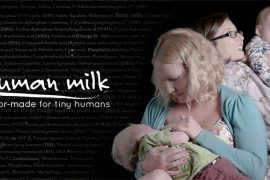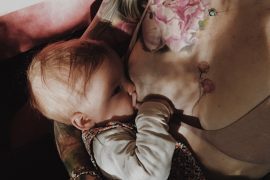Science might say that breastfeeding during pregnancy is safe but that doesn’t mean you have to do it, or that it’s super easy for everyone. There is a wide range of experience and you need to reflect on what feels right for you.
The age of your current nursling might be a factor in your decision. If they are 7 months, you might feel differently than if they were 4 years old and you were getting a bit tired of breastfeeding a plastic truck several times a day.
If your baby is 7 months, or at any age where milk is still a significant proportion of their nutrition, you’ll need to do some thinking. It’s likely they will need an alternative source of milk (still doesn’t mean breastfeeding needs to end). Most women who are breastfeeding when they are pregnant do notice a decrease in milk supply – often a very significant one. This can start as early as the first few weeks after that positive pregnancy test. Whatever you do, your body will be resetting in its lactation story and you will go back to making colostrum during your pregnancy. It happens at different times and some mums might go through a period of feeling like they have virtually nothing and their child is ‘dry nursing’ before colostrum then appears and quantities seem to increase again.
Nurslings behave differently during the changes of pregnancy. Some self-wean as the quantities drop. Some self-wean when things seem to taste a bit different. Some care not a jot that changes are happening and would carry on breastfeeding whatever was coming out or if nothing was. Word of warning: colostrum has a laxative effect. That’s one of the reasons it’s so great for newborns as it helps them to pass meconium. Potty training a toddler? Brace yourself.
Word of warning: colostrum has a laxative effect. That’s one of the reasons it’s so great for newborns as it helps them to pass meconium. Potty training a toddler? Brace yourself.
What else can you expect? For some women, not much else. Pregnant and breastfeeding felt a lot like not pregnant and breastfeeding. You’ve just got to worry about the bump being in the way towards the end. (This was my experience.)
Other women struggle with sore nipples from increased sensitivity that probably has something to do with hormonal changes and sometimes aversion to breastfeeding can be a problem.
The reduction in milk supply can also be upsetting for some. It can come at a time when we might already have mixed feelings about giving birth to another child. We know what positives a new sibling can bring for your toddler but there’s sometimes a feeling of loss or even guilt as we’re concerned how their life is going to change – especially in the first few months. And when milk seems to be going too – that can feel doubly hard. Unfortunately, there isn’t much you can do to increase milk supply in pregnancy when changes are starting. All the usual stuff doesn’t work: pumping, herbs, just feeding more frequently. Many herbs that we might consider when we want to increase production are not thought to be safe in pregnancy. It appears that milk storage is affected for almost all women (only a small minority don’t feel their supply has diminished). You might want to consider using a supplementary feeding system at the breast, so baby can remain attached and get other milk through a lightweight tube.
It’s important to remember though (and this is engraved on the heart of many of us in breastfeeding support) that BREASTFEEDING IS NOT JUST ABOUT MILK. Your little bloke with the plastic truck might not care a jot if supply diminished and milk tastes different because this is only partially about milk. It’s also about connecting to you, relaxation, safety and contentment. That big world out there is only getting bigger and breastfeeding is home.
It’s important to remember though (and this is engraved on the heart of many of us in breastfeeding support) that BREASTFEEDING IS NOT JUST ABOUT MILK.
If you are happy to continue with that, breastfeeding is still working.
You might also be wondering what life is going to be like when the new baby arrives. How does breastfeeding work when there is a newborn and a toddler? Pretty much like it did the last time there was a newborn – nature gets on with it. While breastfeeding during pregnancy doesn’t ‘use up’ colostrum, during in the first few days after the birth, it’s sensible to let the newborn do their thing first before the older nursling gets a turn. And once your mature milk transitions, you can make decisions based on how your newborn’s nappies and weight gain are getting on.
Sometimes there is talk of restricting a baby to one breast and a toddler to another. Most lactation consultants agree that’s not sensible. Ideally you want the newborn to have the option of both and continue to have the option of both fully lactating as their breastfeeding experience continues. Toddlers feeding after newborns are very effective at helping a milk supply to develop and tipping into oversupply is more of a worry than running out of milk. A toddler is also fabulous at relieving engorgement in the early days post-partum. Flashback to my 3-year-old son announcing proudly to his grandmother (not entirely on board with natural term breastfeeding) that he “helped mummy because her milkies were really full”!
Does the toddler feel jealous of the baby having ‘their milk’? I have yet to meet a mother who feels that’s been a problem. In fact, many feel that it can help in the arrival of a new member of the family. Toddlers are likely to need some extra support, but breastfeeding is still there for them. The thing that has always provided comfort and reassurance. And good news! It’s changing back to regular milk and there’s lots more of it! What might not be sensible is weaning a toddler in the last few weeks of pregnancy so if you are thinking tandem breastfeeding really isn’t for you, it might be wiser to wean sooner rather than just prior to baby arriving. If that’s you, I wrote an article on weaning an older child which you might find helpful: http://www.emmapickettbreastfeedingsupport.com/twitter-and-blog/weaning-toddler-bob-and-pre-schooler-billie-how-do-you-stop-breastfeeding-an-older-child
It sometimes happens that an older child who hasn’t breastfed for a while asks to do so again when a new baby is on the scene. That might be because they weren’t a fan of the colostrum. Or there might be some other things going on in their head. Are they ‘testing’ whether they still get to be your baby? Are they just curious? Some resume breastfeeding at this point. Some are happy to have a taste of expressed milk in a cup. Some ask and run away giggling and don’t mention it again. There’s no right or wrong answer on how to deal with this but ideally, we’re looking for ways to minimise rejection and any refusal is done so as gently as possible.
Still think it’s a bit hippy and ‘risky’? This is the American Academy of Family Physicians (folks on the opposite end of the spectrum from hippy and risky):
“Breastfeeding during a subsequent pregnancy is not unusual. If the pregnancy is normal and the mother is healthy, breastfeeding during pregnancy is the woman’s personal decision. If the child is younger than two years, the child is at increased risk of illness if weaned.
Breastfeeding the nursing child during pregnancy and after delivery of the next child (tandem nursing) may help provide a smooth transition psychologically for the older child.”
We can’t guarantee it’s all smooth but breastfeeding through pregnancy and beyond is something mothers have been doing for millennia and there’s very little to fear and lots to embrace. Those of us who do it are often those who have taken the path of child-led weaning and it instinctively feels right to let the nursling make the call. But you’ll make the decision that’s right for you.
After a career as a Deputy Headteacher in central London, Emma initially trained with UK charity Association of Breastfeeding Mothers (www.abm.me.uk), qualifying as a breastfeeding counsellor with them in 2007. She is currently their chair. She qualified as a Board Certified Lactation Consultant (IBCLC) in 2011 and combines a small private practice with volunteering at two groups a week and answering calls on the National Breastfeeding Helpline. You can find her on Twitter as @makesmilk. She spoke at the UNICEF Baby Friendly UK conference in November this year on the theme of responsive feeding. Her book, “You’ve Got It In You: a positive guide to breastfeeding” can be found on Amazon and from other retailers: http://www.amazon.co.uk/dp/B019JE5E44










